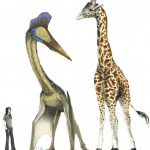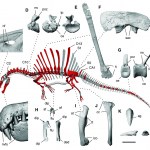paleontology
It wasn't a mammoth, it was a mastodon. But it was still a big hairy elephant featured at the climax-end of the main exhibit hall in the New York State museum. And it was an exhibit to end all exhibits. The New York State Museum, during its heyday, was world class, and the hall of evolution, which seemed old enough to have involved Darwin himself as a consultant, featured the reconstructed skeleton as well as a fur-covered version, of the creature discovered in a kettle only a few miles away. That exhibit, along with a dozen other spectacular exhibits that to my knowledge have not been…
Large hairy elephants got me into paleoanthropology, eventually.
Cohoes Mastodon Exhibit in old New York State Museum, Albany, NY.
I had a strong interest in science, and it was nurtured and expanded by my frequent visits to the New York State Museum, and there was never a doubt in anyone's mind, anywhere, that the coolest exhibit at that museum was the Cohoes Mastodon exhibit. Barbarians eventually came along and tore that exhibit down, along with all the other fantastic and traditional museum displays, when they made the new, slick, produced for consumption and not intense engagement…
The Princeton Field Guide to Prehistoric Mammals ,by Donald R. Prothero, is the first extinct animal book that you, dear reader, are going to give to someone for the holidays.
This book is an interesting idea. Never mind the field guide part for a moment. This isn't really set up like a field guide, though it is produced by the excellent producers of excellent field guides at Princeton. But think about the core idea here. Take every group of mammal, typically at the level of Order (Mammal is class, there are more than two dozen living orders with about 5,000 species) and ask for each one, "…
Ikonokast interviews Don Prothero.
Don Prothero is the author of just over 30 books and a gazillion scientific papers covering a wide range of topics in paleontology and skepticism. Mike Haubrich and I spoke with Don about most of these topics, including the recent history of the skeptics movement, the conflict and potentials between DNA and fossil research, extinctions and impacts, evolution in general, and the interesting projects Don is working on now.
The interview is here. Please click through and give this fascinating conversation a listen!
The number one rule of the Taphonomy Club is don't talk about marks on bones ... without placing them in context. Many marks on bones could have multiple causes, such as putative cut marks caused by stone tools on animal bones found on early hominid sites. In that case, hard sharp stony objects in the ground can cause marks that are hard to tell apart from stone tool marks. But when you find almost all the possible stone tool marks in the exact locations they would be if a hominid was butchering or defleshing the animal, then you can assert that that butchery or defleshing with stone tools…
Much is being made of Brontosaurus. Brontosaurus is a genus name for a large dinosaur, known to watchers of “Land Before Time” as “Long-Necks.” That generic name dates to the 19th century, but in the early 20th century it was eliminated as a proper Linnaean term and replaced with Apatosaurus. This made us sad. Most people discover dinosaurs and learn all about a select handful of the iconic ones, including Brontosaurus, then later learn that Brontosaurs is a bogus name. And become sad.
But perhaps this sadness is all for naught, because a very recent study seems to require the resurrection…
I got a press release about the Waco Mammoth Site that I thought I'd pass on to you:
National Park Service Director Jarvis Participates in Public Meeting about Waco Mammoth Site
WACO, TX – Today, National Park Service Director Jonathan B. Jarvis heard from the citizens of Waco regarding the community’s vision to preserve, protect and enhance the Waco Mammoth Site.
At the invitation of officials from the City of Waco and Baylor University, Jarvis joined the meeting that included significant attendance from local community members and supporters of the site who are interested in protecting the…
Pterosaurs: Natural History, Evolution, Anatomy by Mark P. Witton is a coffee-table size book rich in detail and lavishly illustrated. Witton is a pterosaur expert at the School of Earh and Environmental Sciences at the University of Portsmouth. He is famous for his illustrations and his work in popular media such as the film "Walking With Dinosaurs 3D."
The first pterosaur fossil was found in the late 18th century in the Jurassic Solnhofen Limestones, in Germany, the same excellent preservational environment that would later yield Archaeopteryx. They person who first studied it thought…
It is called Spinosaurus aegyptiacus but it sounds a bit more like Godzilla. Spinosaurus is a theropod dinosaur (that's the groups birds evolved within) found in what is now NOrth Africa, between about 112 and 97 million years ago. It was first discovered about one century ago, though those bones were destroyed during WW II. Spinosaurus aegyptiacus might be the only species of this genus, or there may be two. It is probably the largest carnivours dinosaur, up to 18 meters in length. Up top of the post is the picture from Wikipedia. Although the head looks a lot like a crock, you can see…
I'm sure you've heard. The most complete skeleton of a titanosaur, a newly named species, Dreadnoughtus schrani, is being reported from Argentina.
It is not a bird. I mention that because we've been talking about how birds are dinosaurs lately (see:"Honey, I shrunk the dinosaurs" and "Flying Dinosaurs: A new book on the dinosaur bird link.").
Dreadnoughtus schrani is a sauropod. Brontosaurus, if it existed, would be a sauropod. These are the dinosaurs with the little heads, long necks, and long tails. In cartoons they are sometimes called "long-necks." Dreadnoughtus schrani is, as…
Flying Dinosaurs: How Fearsome Reptiles Became Birds by science writer John Pickrell is coming out in December. As you know I've written a lot about the bird-dinosaur thing (most recently, this: "Honey I Shrunk the Dinosaurs") so of course this sounded very interesting to me. In a way, Pickrell's book is a missing link, in that he writes a lot about the history of paleontology associated with the discovery, undiscovery, and rediscovery of the early bird record and the dinosaur link.
Birds have rewritten dinosaurs. Not all dinosaurs are directly related to birds, but a large number of them…
I remember finding out about the Tethys Sea and being really excited. I was just beginning my studies of Old World prehistory, Africa, and Human Evolution. What I learned about was the remnant sea separating Africa and Eurasia called Tethys, though it is much more than that (see below). Imagine a Eurasia with no Alps, no Caucasus, and no Arabian Peninsula. Much of southern Europe and huge swaths of North Africa are underwater, and Africa is so far away from Eurasia that all the classic seas of the region don't exist simply because they are part of the ocean. If you were in the western…
You all know Don Prothero. He is an active member of the Skeptics and Science Blogging community. He is the author of several books, one of which you are totally supposed to own and if you don't it's kinda lame: Evolution: What the Fossils Say and Why It Matters. It occurred to me today that I never produced a formal review of one of Don's other books that I really enjoyed: Greenhouse of the Dinosaurs: Evolution, Extinction, and the Future of Our Planet. The reason for my skipping that review is that I had a radio interview with Don during which we discussed the topic as some length.…
Study hard and get this guy's job:
I love that book, but when I was a kid they didn't have dinosaurs yet.
How does David Attenborough crawl through a marshy Cycad forest toward an exposed rocky ledge overlooking a vast plain of grazing dinosaurs, drawing ever closer to a nesting colony of Quetzalcoatlus Pterodactlyoids (known in the business as "Flying Giraffes") camera crew in tow, nearly out of breath, turning to the camera and speaking of how his adrenalin is surging as he can feel the breeze caused by wingbeats of one of the larger males taking off down an historically ancient Pterosaur runway, and noting a few interesting facts about their physical adaptations to flight and their behavior…
I have never actually seen a snake eat a crocodile or a crocodile eat a snake, but I am pretty sure I've seen a snake planning to eat a Nile Croc. And that was in the geological present.
In the geological past, about 60 million years ago (during the "Eocene" a.k.a. "dawn age") there was a rain forest that is sort of the ancestor to modern rain forests, which is now a coal deposit (and thus, eventually, will be part of our air) in Columbia. It has yielded interesting materials, and the latest report, just published, is of a fossil dyrosaurid crocodyliform (ancient croc ancestor). It is…
Sometimes interesting scientific evidence shows up in unexpected places. Years ago, there had been discussion of the possibility that immediate post glacial climate in the North Atlantic coastal region was unusually warm, but the evidence was spotty. Then, I was looking through material taken from a geotechnical boring placed to assess the geology of a part of Boston Harbor where a new tunnel was being planned, and found a large fragment of a clam embedded in clay. The clay was deposited during the last glacial maximum and later, and was associated with the melting of glaciers in the…
Today's falsehood1 is the idea of "The Missing Link." You've heard about The Missing Link. You'll hear that some palaeontologist has discovered something and they tell us it is "The Missing Link." Often, it is a supposed "link" between some ancestor of humans (a fossil ape, a monkey, whatever) and us humans. And often, you'll also find that when the press reports a "missing link" the science blogosphere erupts with a torrent flowing over the phrase and the concept, about how there really is no such thing as "The Missing Link," or that this particular report of such a link is spurious, or…
A new species of stork has been identified from Flores, which is the Indonesian island on which the famous "hobbit" fossils have been found. The "hobbit" is a form of hominid (human relative) that seems to be a diminutive form of Homo erectus but different enough from that widespread species to give it a distinct taxonomic status, Homo floresiensis. The Flores hominids were probably about 120 centimeters in height, and the new stork was probably about 180 centimeters in height. The following artist reconstruction is meant to demonstrate bigness of the stork in relation to our diminutive…
In his highly readable book, One Long Argument, Ernst Mayr breaks down the body of thought often referred to as "Darwin's Theory" into five separate and distinct theories, the second of which being "common descent." Darwin's second evolutionary theory (second by Mayr's count, not Darwin's) is really a hypothesis that could be worded this way:
All life on earth descended from a single, original, primordial form that arose eons ago.
The evidence in favor of this hypothesis is strong, but the test of the hypothesis ... the means of disproving it, which is, after all, the point of stating it to…














